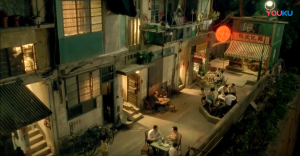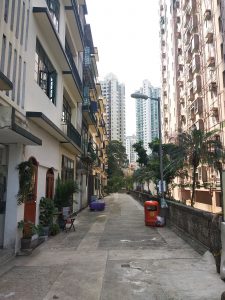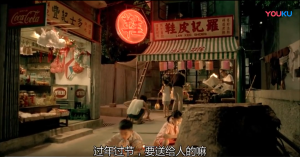Echoes of the Rainbow(歲月神偷), DIR. ALEX LAW (2010)
Wing Lee Street, Sheung Wan, Hong Kong
The film Echoes of the Rainbow is adapted from the childhood experience of the film director Alex Law. It tells the story of a 4-member working-class family living in the 1960s Sham Shui Po, which was one of the poorest areas in the British colonized Hong Kong. Just like many other families in the 1960s, this working-class family has also gone through lots of ups and downs in this turbulent period. Despite all these traumas and grief that the family has experienced, they still need to carry on their lives. The perseverance of the working-class people and their close neighborhood relationship during the colonized period are shown through portraying the family’s life in their small community in the movie.
Wing Lee Street was the site where the film took place. The actual Wing Lee Street is much emptier and less vivid than it was presented in the film. The street was a public space for the neighborhood to interact with each other in the lack-of-entertainment colonized period Hong Kong in the film. It was also a space to present the intimate neighborhood relationship in the old days. However, there were no signs of any residents on the street when I visited there. All I could see was a few tourists taking pictures of this distinctive 60s style street surrounded by the modern high-rise buildings. The warm atmosphere of the community in the film, which could be partly attributed to the warm-tone filter used, contrasts greatly with the cold, indifferent atmosphere of the actual Wing Lee Street. Moreover, the street is still composed of commercial and living spaces, with shops on the ground floor and residential spaces on the upper floors, just like in the film. However, the difference is that the old-fashioned shoe shop, the colonized-style tailor shop, and grocery store run by the neighbors(街坊) in the film were all replaced by the middle-class, modern boutique and hair salon.
Although being included in a government redevelopment program after the release of the film, Wing Lee Street was eventually preserved because this film evoked many Hong Kong people’s emotions to commemorate the spirit of perseverance and mutual assistance in the difficult colonized period. However, Wing Lee Street is no longer the same street as what the audiences see in the film. Wing Lee Street, as opposed to Sham Shui Po, is located in one of the most expensive places in Hong Kong. People living in Wing Lee Street are no longer the working-class, but the more privileged middle-class. The perseverance spirit of the working class presented in the film, which could be shown by continuing to run the small shops despite the severe damages to the shops caused by typhoon 10, cannot be reflected in the deserted street anymore. Although the site of Wing Lee Street has been preserved, the real spirits that Hong Kong people want to preserve disappeared. The street has the shell of the 1960s Hong Kong, but its inner parts are no different from the other ‘placeless structures’ that we can see anywhere in the Hong Kong communities nowadays, cold and dull.
–Jill Chan, 303575906


Left: The busy and crowded street where the protagonist’s family lives. Wing Lee Street, Sheung Wan, Hong Kong. A scene from Echoes of the Rainbow, directed by Alex Law.
Right: The actual Wing Lee Street. Photo taken on 10 March 2021.


Left: The shops run by the neighborhood. Wing Lee Street, Sheung Wan, Hong Kong. A scene from Echoes of the Rainbow, directed by Alex Law.
Right: A western-style boutique in the actual Wing Lee Street. Photo taken on 10 March 2021.

High-rise buildings surrounding Wing Lee Street. Photo taken on 10 March 2021.
Appreciate your reflection on the dilemma of preservation and the seeming inevitability of gentrification. Would you describe the present Wing Lee Street as a “ghost in the shell,” in this case the shell being the street with its buildings and spaces intact and/or renovated? The conclusion of your field observations after having visited the site in Sheung Wan seems to allude to this. Do you see its preservation as the making of a place (through nostalgia) as opposed to a space that continues to be socially produced and reproduced by the people and activities actually inhabiting it? A reflection of the issues you have raised through the class readings on Abbas and de Certeau could offer further depth to your observational analysis. Given that most of the scenes shot of the street were those of the built set, what attributes of Wing Lee Street do you find is given focus in the film that exist in the actual street, if any? A useful dimension to your analysis would be to look into the history of the street such as how it came about and what was it known for before the film brought it to greater public attention, and the public debates that ensue following the cancellation of its development plan and its preservation.